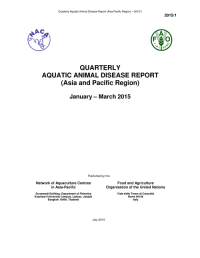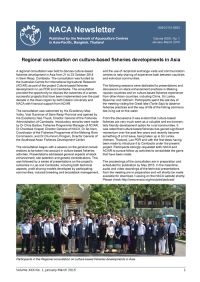Further training provided to aquaculturists in Fiji. Spatial planning for sustainable coastal shrimp production. Availability of grouper (Serranidae) fingerlings and seed in the coral reef of Son Tra Peninsula, central Viet Nam. Small-scale carp seed production through portable FRP hatchery at Khanguri, Odisha. Regional consultation on culture-based fisheries developments in Asia. Gender Assessment Synthesis Workshop. Broodstock management in aquaculture. Urgent appeal to control spread of the shrimp microsporidian parasite Enterocytozoon hepatopenaei (EHP).
In this issue:
Regional consultation on culture-based fisheries developments in Asia. Gender Assessment Synthesis Workshop. NACA participation in the 5th Global Symposium on Gender in Aquaculture and Fisheries, Lucknow, India. Broodstock Management in Aquaculture: Long term effort required for regional capacity building. Urgent appeal to control spread of the shrimp microsporidian parasite Enterocytozoon hepatopenaei (EHP).
The Network of Aquaculture Centres in Asia-Pacific team participated actively during the 5th Global Symposium on Gender in Aquaculture and Fisheries held during 12-15 November 2014, in Lucknow, India. This event was held simultaneously with the 10th Indian Fisheries and Aquaculture Forum and the International Workshop on Aquatic Animal Disease Surveillance The major supporters were NORAD for GAF5 organisation, and USAID for the MARKET Special Workshop and MARKET Gender Project.
Asia produces nearly 90% of world aquaculture output. However, growth of the industry is increasingly constrained by various factors, including poor broodstock quality and genetic deterioration of domesticated stock. This has arisen in part from a general lack of planning, knowledge and skills in broodstock management. Capacity building across the region is urgently required for hatchery operators at different scales through information exchange, experience sharing and training.


